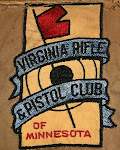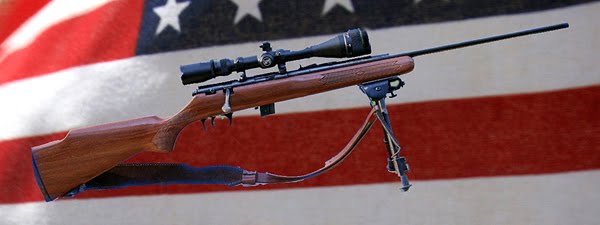 Gray skies met gray gunsmoke at today's Tightwad match when black powder aficionados met, as they do the first Saturday of each month, to compare their skills at the only sport recognized by this country's Founding Fathers: shooting.
Gray skies met gray gunsmoke at today's Tightwad match when black powder aficionados met, as they do the first Saturday of each month, to compare their skills at the only sport recognized by this country's Founding Fathers: shooting.
 A dozen men met at the firing line, shooting at targets from 25 yards to 100 yards using firearms nearly as old as gun history.
A dozen men met at the firing line, shooting at targets from 25 yards to 100 yards using firearms nearly as old as gun history.Serpentine hammered caplocks are what Jedediah Smith, Kit Carson, and hundreds of other trappers and traders carried West of St Louis, through the Golden Arch. Not faster to load than the flintlocks that preceded them, the short stocked Pennsylvania rifle's biggest advantage over the flintlock was its firing system, using a pre-loaded cap rather than powder and flint.
 A shooter's eye view of the scene after firing his rifle. Blackpowder was a mixture of charcoal, sulphur and salt peter and create lots of belching smoke to tickle the nostrils of anyone near. Modern "black powders" like Pyrodex, the original "non-black-black powder", maintain the smokey quality while reducing barrel salts and other deposits famous for fouling gun barrels of old.
A shooter's eye view of the scene after firing his rifle. Blackpowder was a mixture of charcoal, sulphur and salt peter and create lots of belching smoke to tickle the nostrils of anyone near. Modern "black powders" like Pyrodex, the original "non-black-black powder", maintain the smokey quality while reducing barrel salts and other deposits famous for fouling gun barrels of old.
 Davy Crockett was famous for his coonskin cap- which some historians argue as being folk-lore- and muzzle loading die-hards enjoy the accoutrement's that bring to mind the colorful clothing of past generations. (Kids today are not quite so colorful, though think they're being "new and original!)
Davy Crockett was famous for his coonskin cap- which some historians argue as being folk-lore- and muzzle loading die-hards enjoy the accoutrement's that bring to mind the colorful clothing of past generations. (Kids today are not quite so colorful, though think they're being "new and original!)

Muzzle loading is the original method of shooting black powder. Modern "black powder rifles" tend toward breech loading and using shotgun primers to ignite the charge.
The patch and ball are started down the barrel with- what else but-- "starter" rod. Once begun, the job is finished with a full-length ramrod.
 Flintlocks are the weapons used by the First Americans. The dragon headed serpentine hammer holding the chip of flint, a dash of powder dropped into the pan, and ignited by a spark off the frizzen, these guns lead to many expressions we use today.
Flintlocks are the weapons used by the First Americans. The dragon headed serpentine hammer holding the chip of flint, a dash of powder dropped into the pan, and ignited by a spark off the frizzen, these guns lead to many expressions we use today. Ornate and beautiful in their design, flintlocks and cap-n-ball bring us to the roots of our shooting sports today.
Ornate and beautiful in their design, flintlocks and cap-n-ball bring us to the roots of our shooting sports today. If you've not yet tried a "smokepole", head on down to the range the first Saturday of the month- I'm sure there's someone there who'd let you give it a try. You don't know what you're missing- and that's a lot! Contact Reed and ask him about it, he may be just the one to show you the ropes.
If you've not yet tried a "smokepole", head on down to the range the first Saturday of the month- I'm sure there's someone there who'd let you give it a try. You don't know what you're missing- and that's a lot! Contact Reed and ask him about it, he may be just the one to show you the ropes.
 A shooter's eye view of the scene after firing his rifle. Blackpowder was a mixture of charcoal, sulphur and salt peter and create lots of belching smoke to tickle the nostrils of anyone near. Modern "black powders" like Pyrodex, the original "non-black-black powder", maintain the smokey quality while reducing barrel salts and other deposits famous for fouling gun barrels of old.
A shooter's eye view of the scene after firing his rifle. Blackpowder was a mixture of charcoal, sulphur and salt peter and create lots of belching smoke to tickle the nostrils of anyone near. Modern "black powders" like Pyrodex, the original "non-black-black powder", maintain the smokey quality while reducing barrel salts and other deposits famous for fouling gun barrels of old. Davy Crockett was famous for his coonskin cap- which some historians argue as being folk-lore- and muzzle loading die-hards enjoy the accoutrement's that bring to mind the colorful clothing of past generations. (Kids today are not quite so colorful, though think they're being "new and original!)
Davy Crockett was famous for his coonskin cap- which some historians argue as being folk-lore- and muzzle loading die-hards enjoy the accoutrement's that bring to mind the colorful clothing of past generations. (Kids today are not quite so colorful, though think they're being "new and original!)
Muzzle loading is the original method of shooting black powder. Modern "black powder rifles" tend toward breech loading and using shotgun primers to ignite the charge.
But to really enjoy your shooting heritage, do it the old fashioned, original way: one move at a time.
(Snap a 'cap' before loading to insure the flash hole and barrel are clear.)
Drop in a measure of powder, cover the muzzle with a patch, place a ball on the cloth, snip the cloth flush with the barrel and ram that baby down... get the patch and ball tight against the powder charge.

The patch and ball are started down the barrel with- what else but-- "starter" rod. Once begun, the job is finished with a full-length ramrod.
 Flintlocks are the weapons used by the First Americans. The dragon headed serpentine hammer holding the chip of flint, a dash of powder dropped into the pan, and ignited by a spark off the frizzen, these guns lead to many expressions we use today.
Flintlocks are the weapons used by the First Americans. The dragon headed serpentine hammer holding the chip of flint, a dash of powder dropped into the pan, and ignited by a spark off the frizzen, these guns lead to many expressions we use today."Flash in the pan," may mean less today than it did in 1760 when one wanted more than a flash in the pan, but the powder charge to ignite as well. But the meaning is the same: "flash in the pan" being a useless, albeit a bright, spark.
 Ornate and beautiful in their design, flintlocks and cap-n-ball bring us to the roots of our shooting sports today.
Ornate and beautiful in their design, flintlocks and cap-n-ball bring us to the roots of our shooting sports today.Whether we admire Johnny Tremain or Daniel Boone or Kit Carson, black powder firearms can make one marvel at the shooting skills of our ancestors. Anyone who's attempted a 100 yard, or more, shot at a six inch bullseye with a black powder rifle will really appreciate our modern smokeless cartridges and firearms.
 If you've not yet tried a "smokepole", head on down to the range the first Saturday of the month- I'm sure there's someone there who'd let you give it a try. You don't know what you're missing- and that's a lot! Contact Reed and ask him about it, he may be just the one to show you the ropes.
If you've not yet tried a "smokepole", head on down to the range the first Saturday of the month- I'm sure there's someone there who'd let you give it a try. You don't know what you're missing- and that's a lot! Contact Reed and ask him about it, he may be just the one to show you the ropes.(Scores for the shoot will be posted soon as they arrive in house.)
Saturday, May 8th, is the first of the season's Cowboy Shoots- S.A.S.S. recognized- and another opportunity to try out some weapons as old, or older, than most of our grandfathers. Be sure to stop by and watch the action. Better still, get involved! You never know what you're missing until you try it a time or two.
Saturday, May 8th, is the first of the season's Cowboy Shoots- S.A.S.S. recognized- and another opportunity to try out some weapons as old, or older, than most of our grandfathers. Be sure to stop by and watch the action. Better still, get involved! You never know what you're missing until you try it a time or two.
Till next time- keep your powder dry and your wad knife sharp. And don't forget: it ain't unloaded till you check, and keep the muzzle downrange.
Jim III



No comments:
Post a Comment